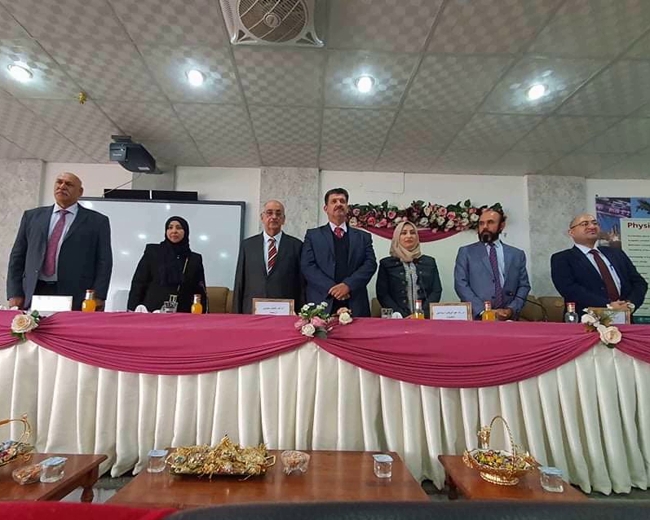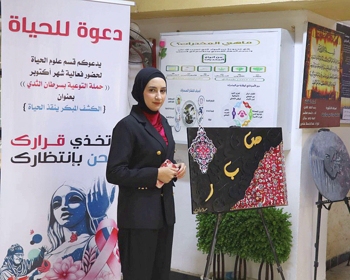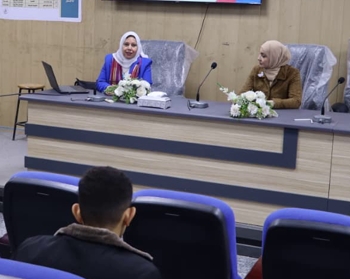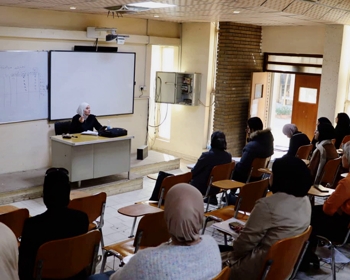ناقش قسم الفيزياء في كلية التربية للعلوم الصرفة (ابن الهيثم) أطروحة الدكتوراه الموسومة ( أغشية رقيقة ضوئية CdTe / CdS) للطالبة ( وديان كاظم عبد ) التي انجزتها تحت اشراف مشترك من قبل التدريسي المتقاعد من القسم ( أ.د سمير عطا مكي ) مع ( رئيس الباحثين د. فلاح إبراهيم العطار ) من وزارة العلوم و التكنولوجيا ، و نوقشت من قبل أعضاء لجنة المناقشة المبينة أسمائهم فيما يأتي :
-
أ.د. نادر فاضل حبوبي (رئيسا)
-
أ.د. رائد عبد الوهاب إسماعيل (عضوا)
-
أ.د. هادي جبار مجبل (عضوا)
-
أ.د. بشرى كاظم حسون (عضوا)
-
أ.م.د. علي حسين عبد الزاق (عضوا)
-
أ.د. سمير عطا مكي (عضوا ومشرفا)
-
ر. باحثين د. فلاح إبراهيم مصطفى العطار (عضوا ومشرفا)
ويهدف البحث الى :
-
دراسة تحضير وخصائص الجسيمات النانوية CdS و CdTe الغروية (NPS) عن طريق الانحلال الحراري بالرش الكيميائي والاستئصال بالليزر النبضي في السوائل (PLAL).
-
دراسة المورفولوجيا والهيكلية والكيميائية للسيليكون المسامي الناتج عن الحفر الكهروكيميائي الضوئي.
-
تصنيع وتوصيف Al / CdS / CdTe / n-Si / Al ، Al / CdS / CdTe / PSi / n-Si / Al و FTO / CdS / CdTe / Al غير المتجانسة للخلية الشمسية والكاشف الضوئي.
وتم في هذا البحث تحضير اغشية رقيقة من CdS بسمك 200 25nm نانومتر على ركائز زجاجية مسخنة مسبقًا بدرجة (300-3500) درجة مئوية باستخدام تقنيات الانحلال الحراري بالرش الكيميائي وتم تحضير الجسيمات النانوية CdTe الغروية بواسطة الاستئصال بالليزر في سائل باستخدام ليزر Nd – YAG بطول موجي (1064) نانومتر، طاقة الليزر400 ملي جول ، وعرض نبضة 7 نانومتر ، و بتكرار 10هرتز ووقت الاستئصال لمدة 5 دقائق لهدف CdTe المغمورة في 5 مل من الميثانول المطلق. تم استخدام طريقة الصب بالتنقيط لتحضير أغشية رقيقة بسمك 600 ± 25 نانومتر.
كشفت قياسات حيود الأشعة السينية (XRD) أن التركيب البلوري للأغشية الرقيقة CdS هو المكعب والسداسي واغشية ال CdTe لها هيكل مكعب لجميع العينات المرسبة والملدنة بدرجة (150-300) سليزي. تم استخدام تقنية AFM لدراسة التضاريس وتقدير خشونة السطح ومتوسط حجم الحبيبات لـ CdS وCdTe، وأظهرت النتائج أن حجم الحبيبات يزداد مع التلدين. أظهر الفحص المجهري الإلكتروني (SEM) تكوين أغشية ذات بنية نانوية، وتتفق هذه النتيجة مع حيود الأشعة السينية مع اختلاف طفيف بين القياسين. أظهر المجهر الإلكتروني للإرسال أن الجسيمات النانوية CdS وCdTe كانت جسيمات نانوية شبه كروية أو كروية الشكل. تم تسجيل أطياف الامتصاص والنفاذية في نطاق الطول الموجي (300-1100) نانومتر. تم حساب فجوة الطاقة المحظورة للانتقال الإلكترونية، وكانت قيمة فجوة الطاقة في الانتقال المباشر المسموح به (2.31 و2.29 و2.28) فولت (3.8 و2.7 و2.69) فولت لـ CdS و CdTe على التوالي، حيث ان فجوة الطاقة تنخفض مع زيادة درجة حرارة التلدين. كما تم حساب معامل الامتصاص ومعامل الخمود. أظهرت قياسات الخواص الكهربائية للأغشية الرقيقة CdS و CdTe زيادة التوصيلة الكهربائية مع زيادة درجة حرارة التلدين وجميع أغشية CdS لها طاقتا تنشيط وقيمة واحدة لطاقة التنشيط لـ CdTe. أظهرت نتائج تأثير هول لأفلام CdS أن جميع الأفلام لها موصلية (نوع n) بينما أفلام CdTe لها موصلية كهربائية موجبة (نوع p).
تم تحضير طبقات السيليكون المسامية (PSi) بطريقة النقش الكهروكيميائية الضوئية على رقائق السيليكون من النوع n بكثافة تيار 10 مللي أمبير / سم 2 ووقت النقش 10 دقائق. تمت دراسة الخصائص التركيبية بواسطة حيود XRD، ووجدت الحجم البلوري (74.42) نانومتر ، = 69.6 درجة ، FWHM=0.13درجة. شكل السطح الذي درس بواسطة الفحص المجهري للقوة الذرية، حيث اظهرت الصورة سطحًا مساميًا منتظم تقريبًا يشبه الإسفنج البحري. من قياس FTIR، وجدت الروابط المكونة لهيكل السيليكون المسامي Si-H و Si-O-Si وظهور روابط أخرى مثل C-H و C-H2. أخيرًا، تم فحص الخصائص الضوئية للسيليكون المسامي عن طريق استخدام التلألؤ الضوئي (PL)، حيث وجد ذروة انبعاث عند 688 نانومتر.
في هذا البحث تم تصنيع الخلية الشمسية من (Al / CdS / CdTe / n-Si / Al) و (Al / CdS / CdTe / Psi / n-Si / Al) و (FTO / CdS / CdTe / Al). وكانت أقصى قيمة للكفاءة 8%. بالإضافة إلى ذلك، نجحنا في تصنيع جهاز الكشف الضوئي، حيث تبلغ القيمة القصوى للاستجابة الطيفية(Rl) حوالي A/W 0.83 و 0.9 لـ Al / CdS / CdTe / Si / Al و Al / CdS / CdTe / Psi / Si / Al على التوالي. وجدت اقصى قيمة للكشفية النوعية ( ) ( (1.2 x 1013 W-1 .cm.Hz1/2 عند الطول الموجي 900 نانومتر للكاشف الضوئي CdS/CdTe/n-Si و((1.3 x 1013 W-1 .cm.Hz1/2 للكاشف الضوئي Al/CdS/CdTe/Psi/Si/Al
……………………………………………………………………………………………………………………………..
Title: CdTe/CdS Photovoltaic Thin Films
Name: Wedian Kadhoum Abad
Supervisor: Prof. Dr.Samir Ata Maki
Chief Researcher Dr. Falah I. Mustafa Alattar
The Aim of work
-
Preparation and characteristics study of colloidal CdS and CdTe nanoparticles (NPS) by Chemical Spray pyrolysis and pulse laser ablation in liquids (PLAL).
-
Study the Morphological, Structural and Chemical of Porous Silicon (PSi) Produced by Photoelectrochemical Etching.
-
Fabrication and characterization of Al/CdS /CdTe/n-Si/Al, Al/CdS /CdTe/PSi/n-Si/Al and FTO/CdS/CdTe /Al heterojunction for solar cell and Photodetector.
-
Abstract
In this work, thin films of CdS with thickness 200 25nm have been prepared on pre-heated glass substrates up to (300-3500C) by chemical spray pyrolysis techniques. Nanoparticals of CdTe prepared by pulsed laser ablation in liquids, using Nd–YAG laser at 1064 nm wavelength, laser energy 400mJ, 7 ns pulse width, 10 Hz repetition and ablation time was 5 min for CdTe target immersed in 5 ml of methanol absolute. The drop casting method was used to prepare thin films with thickness 600 25nm.
X-ray diffraction (XRD) measurements appeared the cubic and hexagonal crystal structure of CdS and CdTe thin films have the cubic structure for all samples a deposited and annealing at (150,300)oC. AFM technique used to study topography and estimate the surface roughness and average grain size for CdS and CdTe , the results show that the grain size increase with annealing. Scanning electron microscopy (SEM) showed the formation of films with nanostructure this result agrees with that obtained from X-ray diffraction with a slight difference between the two measurements. Transmission electron microscopy exhibited that the CdS and CdTe nanoparticles were semispherical or ball shape nanoparticles. The absorbance and transmittance spectra were reported in the range of wavelengths (300-1100) nm. The energy gap in the electronic transition was determined, the value of the energy gap in the permissible direct transition was eV (2.31, 2.29 and 2.28) for CdS and CdTe (3.8, 2.7 and 2.69), respectively, Where the energy gap decreases with the temperature rise of the annealing. Also, the coefficient of absorption and extinction was determined. The electrical properties measurements for CdS and CdTe thin films showed that increasing the electric conductivity with increasing annealing temperature and all CdS films have two activation energies and one value of activation energy for CdTe. Hall Effect results for CdS films showed all films have (n-type) conductivity while CdTe films have positive n electrical conductivity (p-type).
Porous silicon (PSi) layers prepared by Photoelectrochemical-etching method on n-type silicon wafers with current density 10mA/cm2and etching time 10 min. The structural properties were studied by XRD diffraction, it found the crystalline size (74.42) nm, 2θ=69.6°, FWHM (0.13) deg. The surface morphology studying by Atomic force microscopy, where the image shows a nearly uniform porous surface, Sea sponge-like. From the FTIR measurement, the constituent bonds of the porous silicon structure found Si-H and Si-O-Si and the appearance of other bonds such as C-H and C-H2. Finally, the optical properties of porous silicon was investigated by employing photoluminescence (PL), where it found an emission peak at 688 nm.
In this research solar cell fabricated from (Al/CdS/CdTe/n-Si/Al), (Al/CdS/CdTe/Psi/n-Si/Al) and (FTO /CdS/CdTe /Al). We get the maximum values of efficiency 8%. In addition, we successful manufacture of Photodetector, where the maximum value of the spectral responsivity (Rl) of Al/CdS/CdTe /Si/Al and Al/CdS/CdTe/Psi/Si/Al Photodetector is around 0.83 and 0.9 A/W respectively. The maximum specific detectivity value ( ) is found to be 1.2 x 1013 W-1 .cm.Hz1/2 at wavelength 900 nm for CdS/CdTe/n-Si Photodetector and 1.3 x 1013 W-1 .cm.Hz1/2 for Al/CdS/CdTe/Psi/Si/Al Photodetector .
Future works
-
Preparing and doping (CdS and CdTe) thin films using evaporation and sputtering methods for the solar cell and comparing the obtained results with the current study.
-
Deposition the (CdS and CdTe) thin films onto Germanium Wafer and FTO substrates, then comparing the resulting efficiency of the two cases on hand, and the obtained efficiency from the current study on the other hand.
-
Studying the effect of doping the elements (Al, Ge, Ga, Bi) on the structural, optical and electrical properties of CdS and CdTe films and comparing the results with the current study.
-
Benefits from the studying results to manufacture detector works within the region (UV) of the electromagnetic spectrum.
-
Investigation the effect of oxidation of porous silicon on the characteristics of Photodetector and solar cell.
-
Using the spin coating technique instead of drop casting for the deposition of CdS and CdTe nanoparticles film.











